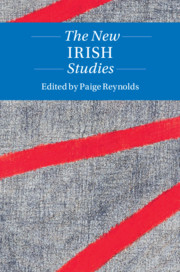Book contents
- The New Irish Studies
- Twenty-First-Century Critical Revisions
- The New Irish Studies
- Copyright page
- Contents
- Notes on Contributors
- Acknowledgments
- Introduction
- Part One Legacies
- Part Two Contemporary Conditions
- Part Three Forms and Practices
- Chapter 11 Ireland’s Real Economy: Postcrash Fictions of the Celtic Tiger
- Chapter 12 Northern Irish Poetry
- Chapter 13 Essayism in Contemporary Ireland
- Chapter 14 Killers, Lovers, and Teens: Contemporary Genre Fiction
- Chapter 15 “One Hundred Years a Nation”: New Modes of Commemoration
- Chapter 16 Coda: A New Irish Studies
- Index
Chapter 14 - Killers, Lovers, and Teens: Contemporary Genre Fiction
from Part Three - Forms and Practices
Published online by Cambridge University Press: 18 September 2020
- The New Irish Studies
- Twenty-First-Century Critical Revisions
- The New Irish Studies
- Copyright page
- Contents
- Notes on Contributors
- Acknowledgments
- Introduction
- Part One Legacies
- Part Two Contemporary Conditions
- Part Three Forms and Practices
- Chapter 11 Ireland’s Real Economy: Postcrash Fictions of the Celtic Tiger
- Chapter 12 Northern Irish Poetry
- Chapter 13 Essayism in Contemporary Ireland
- Chapter 14 Killers, Lovers, and Teens: Contemporary Genre Fiction
- Chapter 15 “One Hundred Years a Nation”: New Modes of Commemoration
- Chapter 16 Coda: A New Irish Studies
- Index
Summary
The display shelves of Irish bookstores, while showcasing the occasional Yeats collection or Joyce novel, are filled largely with crime fiction, romance novels, and young adult (YA) books. This chapter surveys the status of the crime novel in Ireland, a topic that has drawn established “highbrow” writers such as John Banville, who writes successful crime novels under the pseudonym of Benjamin Bratton, as well as other talented scribes including Tana French. This chapter also examines the popular romance, or “chick lit” – a genre dominated by Irish women writers since the days of Rosa Mulholland – and its success in work by Marian Keyes, Cecelia Ahern, and Sarah Harte. It also attends to the growing influence of children’s and young adult fiction, particularly focusing on the boom in YA fiction, led by writers such as Louise O’Neill. What do these books, and their popularity, tell us about contemporary Ireland? Are these forms of genre fiction inherently conservative?
Keywords
- Type
- Chapter
- Information
- The New Irish Studies , pp. 244 - 258Publisher: Cambridge University PressPrint publication year: 2020
- 1
- Cited by

